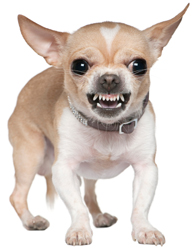 Typically when you think of aggression you may picture a certain breed of dog, standing on his toes with his teeth bared, growling, barking and lunging towards a human or another animal. While these are all signs of a dog’s body language that he should not be messed with at that point, it does not always point in the direction of true canine aggression. In fact, true aggression is an incredibly rare thing among dogs, while the large majority of dogs who are labeled as dangerous or aggressive are simply acting out in the only way they know as a defensive measure. This is a fear response, and can stem from things such as a lack of, or improper socialization to a past of abuse and pain. Most of these dogs do not trust, or do not trust easily. Respect must be taken to help these dogs through their aggressive actions to help them become relaxed, safe canine companions.
Typically when you think of aggression you may picture a certain breed of dog, standing on his toes with his teeth bared, growling, barking and lunging towards a human or another animal. While these are all signs of a dog’s body language that he should not be messed with at that point, it does not always point in the direction of true canine aggression. In fact, true aggression is an incredibly rare thing among dogs, while the large majority of dogs who are labeled as dangerous or aggressive are simply acting out in the only way they know as a defensive measure. This is a fear response, and can stem from things such as a lack of, or improper socialization to a past of abuse and pain. Most of these dogs do not trust, or do not trust easily. Respect must be taken to help these dogs through their aggressive actions to help them become relaxed, safe canine companions.
It’s In The Context
Judging and examining the context of any dog’s behavior is essential to figuring out the cause so that you can begin fixing the situation. Dogs are not randomly aggressive, nor do they attack unprovoked. When dog bites happen and humans claimed the dog was unpredictable, it’s typically a case of the human not reading the dog’s body language and context of the situation. For example, a dog bites a child during play, and the adult claims the dog was vicious. What probably happened was that the child was playing with a dog who was either in pain, sick, or wanted to be left alone for one reason or another. The dog gave his signals, such as yawning, averting his gaze, showing the whites of his eyes called whale eye, and maybe even growling. When these are ignored, the dog feels threatened and takes action to protect himself, biting the child. This could have been fear of being hurt by the child, or maybe the child was too loud, too fast and rambunctious for the dog. It’s all in the context of the situation.
Another example is barking, growling and lunging on leash. This is often considered aggression towards people or other dogs, whichever triggers this response. However, this is typically just a reaction to an emotional response that the dog is feeling when he sees these triggers. Most often, he is acting defensively due to not knowing any other way to react to seeing these things. This tends to happen with dogs who were not socialized or trained earlier in their lives. He was not taught how to react, or not react at all, to seeing people or other dogs, and so he made his own choice that they are a threat and he must protect himself from them. This can be curbed through desensitization, counter condition and leash training.
Your Reaction Matters
How you, or anyone else, reacts to a dog that acts out either in aggression, fear aggression or frustration matters significantly in how the entire scenario progresses. Too many people make an attempt to punish a dog for barking, growling and curling his lips. Unfortunately, this makes matter much worse for everyone involved. These behaviors are a dog’s warning signs. If he is taught not to use them at all when he is feeling uncomfortable, scared or threatened, then you have no way of knowing how he is feeling, and a bite could come sooner rather than later due to no noted visual cues first.
Instead of focusing on the reaction itself, focus on the cause. Again, this takes us back to the context of the situation. What is going on that is making your dog scare or upset? How can you fix it? It could be that he simply needs some extra socialization or even desensitization with something that he is afraid of. He may need counter conditioning so that he will not over react to something that is, in reality, completely harmless. Take control of the situation to better it instead of punishing your dog for doing what comes naturally to him.
You can bring harmony into an aggressive or fear aggressive dog and help turn him into a safe and loving companion for life. When in doubt, always ask for the help of a professional private trainer or behavior modification instructor with experience. When a dog shows his teeth, growls, or reacts in any way that may make his safety and the safety of the people around him questionable, it is time to take action and fix the context of the situation!
Visit Pampered Paw Gifts.com For Gifts and Treats For Your Dog